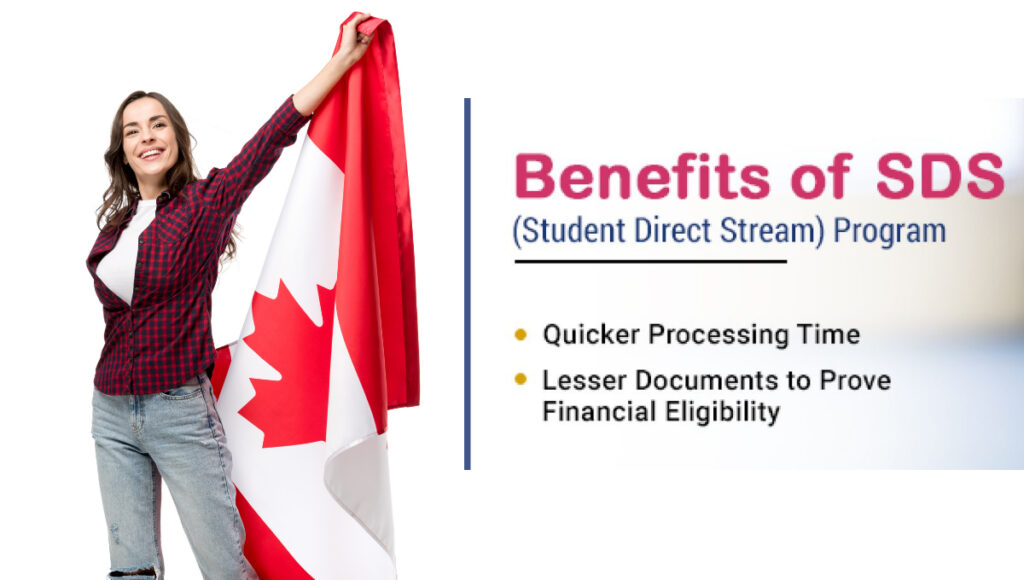Navigating the Student Direct Stream (SDS) for Studying in Canada
Introduction:
Studying abroad is a dream shared by countless students around the world. Canada, with its welcoming atmosphere, top-notch education system, and vibrant cultural scene, has become a magnet for international students seeking quality higher education. Among the various pathways available, the Student Direct Stream (SDS) stands out as an efficient and streamlined route to studying in Canada. In this comprehensive guide, we’ll dive into the details of the SDS program, its advantages, eligibility requirements, application process, and tips to ensure a successful journey to Canadian academia.
Understanding the Student Direct Stream (SDS):
The Student Direct Stream is a fast-track program introduced by the Government of Canada to expedite the study permit applicationprocess for eligible international students. Launched in 2018, the SDS aims to simplify and accelerate the process of obtaining a study permit, ensuring that qualified students can transition smoothly into their Canadian education experience.
Benefits of the SDS Program:
1.Accelerated Processing Times: One of the most significant advantages of the SDS program is its faster processing times. While regular study permit applications can take several weeks or even months to process, SDS applications are typically processed within a few weeks, allowing students to plan their academic journey with greater certainty and efficiency.
2.Pre-Approval of Funds: Under the SDS program, applicants are required to provide proof of sufficient funds to cover their tuition fees, living expenses, and return transportation. Once these funds are demonstrated upfront, students receive a letter of pre-approval, which simplifies subsequent stages of the application process.
3.Predictable Documentation Requirements: The SDS program comes with clear and predictable documentation guidelines. This reduces the likelihood of misunderstandings or delays due to incomplete or inconsistent documentation.
4.Enhanced Study Experience: By opting for the SDS route, students can start their academic studies sooner, allowing them to immerse themselves in Canadian education, culture, and campus life without unnecessary delays.
Eligibility Criteria for the SDS Program:

To be eligible for the SDS program, applicants must meet certain criteria. These include, but are not limited to:
1.Country of Residence: The SDS program is open to residents of select countries, including China, India, the Philippines, Vietnam, Pakistan, Morocco, and Senegal. It’s important to check the official list of eligible countries before applying.
2.Acceptance from a Designated Learning Institution (DLI): Applicants must receive an acceptance letter from a Designated Learning Institution (DLI) in Canada for a program that is at least six months in duration.
3.Language Proficiency: Proof of language proficiency is required. Most students need to take an approved language test, such as the International English Language Testing System (IELTS) or the Test of English as a Foreign Language (TOEFL).
4.Sufficient Funds: Applicants must demonstrate that they have sufficient funds to cover tuition fees, living expenses, and return transportation for themselves and any family members accompanying them.
5.Guaranteed Investment Certificate (GIC): In some cases, students are required to purchase a Guaranteed Investment Certificate (GIC) of $10,000 CAD to cover initial living expenses.
Application Process for the SDS Program:
1.Acceptance Letter: Secure an acceptance letter from a Designated Learning Institution (DLI) in Canada for a qualifying program.
2.Language Proficiency: Take an approved language test and achieve the required minimum score.
3.Proof of Funds: Gather the necessary funds and obtain a Guaranteed Investment Certificate (GIC) if applicable.
4.Medical Exam: Complete a medical examination if required.
5.Online Application: Apply through the Immigration, Refugees and Citizenship Canada (IRCC) portal, ensuring all required documents are accurately submitted.
6.Biometrics and Interview: Some applicants may need to provide biometric information and attend an interview at a local Visa Application Center (VAC).
7.Study Permit Issuance: Upon approval, successful applicants will receive their study permit, granting them the opportunity to study and reside in Canada.
Tips for a Successful SDS Application:
1.Thoroughly Review Eligibility Requirements: Carefully review the eligibility criteria and ensure you meet all the necessary conditions before applying.
2.Plan Ahead: Begin the application process well in advance to account for potential processing times and unforeseen delays.
3.Accurate Documentation: Ensure all documentation, including language test scores, financial documents, and acceptance letters, are accurate and up-to-date.
4.Complete Applications: Fill out the application form accurately and completely to avoid any unnecessary delays.
5.Financial Planning: Plan your finances carefully and ensure you have the required funds readily available.
6.Health Insurance: Explore health insurance options to ensure you have adequate coverage during your stay in Canada.
7.Adhere to Deadlines: Pay close attention to application deadlines to avoid missing out on this expedited process.
Conclusion:
The Student Direct Stream (SDS) program has become a beacon of opportunity for international students aspiring to pursue their education in Canada. With its swift processing times, pre-approval of funds, and clear documentation guidelines, the SDS program offers a straightforward and efficient path to realizing your academic dreams in one of the world’s most sought-after study destinations. By understanding the eligibility criteria, meticulously preparing your application, and planning ahead, you can navigate the SDS program successfully and embark on a transformative journey of learning, growth, and cultural enrichment in Canada.

